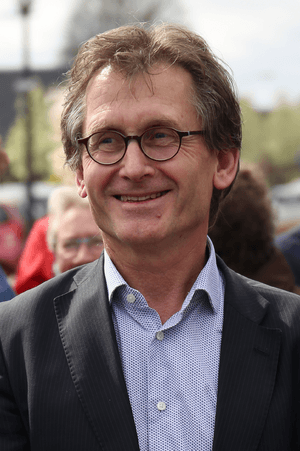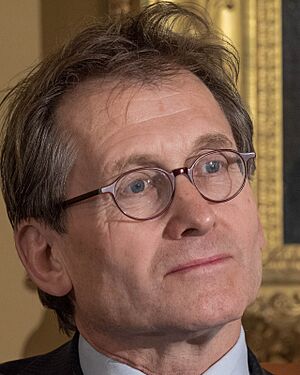Ben Feringa facts for kids
Quick facts for kids
Ben Feringa
|
|
|---|---|

Ben Feringa in 2017
|
|
| Born |
Bernard Lucas Feringa
18 May 1951 Barger-Compascuum, Netherlands
|
| Nationality | Dutch |
| Alma mater | University of Groningen |
| Known for | Molecular switches/motors, Homogeneous catalysis, stereochemistry, photochemistry |
| Spouse(s) | Betty Feringa |
| Awards | Nobel Prize in Chemistry (2016) |
| Scientific career | |
| Fields | Organic Chemistry Materials Science Nanotechnology Photochemistry |
| Institutions | University of Groningen (1984–present) Royal Dutch Shell (1979–1984) |
| Thesis | Asymmetric oxidation of phenols. Atropisomerism and optical activity (1978) |
| Doctoral advisor | Hans Wijnberg |
Bernard Lucas "Ben" Feringa is a famous Dutch scientist. He was born on May 18, 1951. He is a chemist who works with organic chemistry. This field studies chemicals that contain carbon.
Ben Feringa is a top expert in molecular nanotechnology. This is about building tiny machines from molecules. He also specializes in homogeneous catalysis, which uses special substances called catalysts to speed up chemical reactions. He is a distinguished professor at the University of Groningen in the Netherlands.
In 2016, he won the Nobel Prize in Chemistry. He shared this award with two other scientists, Sir J. Fraser Stoddart and Jean-Pierre Sauvage. They won for their amazing work on designing and building tiny molecular machines.
Contents
Ben Feringa's Early Life
Ben Feringa grew up in a large family. He was the second of ten children. His family lived on a farm in Barger-Compascuum, a village in the Netherlands. This farm was very close to the German border.
He spent his childhood helping out on the farm. He is married to Betty Feringa, and they have three daughters. Today, he lives in Paterswolde, which is near the city of Groningen.
Ben Feringa's Career in Science
Ben Feringa studied at the University of Groningen. He earned his first degree in 1974. Then, he completed his PhD in 1978 at the same university. His PhD research was about how to make certain molecules in a specific way.
After working for a short time at Shell, a big company, he returned to the University of Groningen in 1984. He became a full professor there in 1988. Early in his career, he focused on using catalysts to control chemical reactions. He also worked on stereochemistry, which is about the 3D arrangement of atoms in molecules.
In the 1990s, his work in stereochemistry led to exciting discoveries in photochemistry. This is the study of how light affects chemical reactions. He created the first molecular motor that could spin in one direction using light. Later, he even made a tiny "molecular car" that could move with electricity.
Ben Feringa has created many new inventions. He holds over 30 patents for his discoveries. He has also written more than 650 scientific papers. These papers have been used by other scientists over 30,000 times. He has also guided more than 100 students in their PhD studies.
Amazing Molecular Machines
Ben Feringa's most famous work is on molecular machines. These are incredibly tiny devices built from individual molecules. He discovered how to make molecular motors that spin in one direction. This is similar to how natural processes work, like how light makes a molecule in your eye (retinal) spin.
His work laid the foundation for future nanotechnology. This field aims to build tiny machines and nanorobots that could be powered by these molecular motors. He designed and built tiny molecular switches and motors. This opened up new ways to create complex chemical systems.
How Molecular Machines Can Be Used
The molecular switches developed by Feringa's team have many possible uses. They can be used in materials that change when light hits them. They can also be used in liquid crystals, which are found in screens. Scientists are also exploring their use in DNA as a way to store memory.
These tiny machines could also help with drug delivery. They might be used to create new drugs to fight cancer or antibiotic resistance. Imagine tiny robots delivering medicine exactly where it's needed!
Feringa's team also showed that these motors can work when attached to surfaces. This is important for building future nanomachines, like a molecular conveyor belt. They even showed that these motors can make larger objects spin when mixed with liquid crystals.
The Molecular Nanocar
In 2011, Feringa's team created a molecular "nanocar". This molecule had wheels made from molecular motors. They showed that this tiny car could move on a solid surface when an electric current was applied. This discovery was featured in newspapers and magazines around the world.
His work is helping to create a new field called Systems chemistry. This involves building complex chemical systems that can do many things at once. For example, they developed a special catalyst that can be turned on or off using a molecular motor. This takes the design of molecular machines to a whole new level.
Awards and Recognition
Ben Feringa has received many honors and awards for his scientific work. He is a member of many important scientific groups. For example, he was elected a Fellow of the Royal Society of Chemistry in 1998. In 2004, he became an International Honorary Member of the American Academy of Arts and Sciences.
He is also an elected member of the Royal Netherlands Academy of Arts and Sciences (KNAW) since 2006. He even served as the vice-president of the science division there.
Major Awards
Feringa has won many prestigious awards for his research. These include:
- The Körber European Science Prize in 2003.
- The Spinoza Prize in 2004, one of the highest awards in Dutch science.
- The Prelog Gold Medal in 2005.
- The James Flack Norris Award in Physical Organic Chemistry in 2007.
- The Paracelsus Award in 2008.
- The Chirality Medal in 2010 for his work on stereochemistry.
- The Arthur C. Cope Scholar Award.
- The Nagoya Medal of Organic Chemistry.
- The Grand Prix Scientifique Cino del Duca in 2012.
- The Humboldt award in 2012.
- The Lily European Distinguished Science Award in 2013.
- The Marie Curie Medal in 2013.
- The "Chemistry for the future Solvay prize" in 2015. This award recognized his groundbreaking work on molecular motors.
The Nobel Prize
On December 20, 2016, Ben Feringa received the Nobel Prize in Chemistry. He shared this incredible honor with Sir J. Fraser Stoddart and Jean-Pierre Sauvage. They were recognized for their pioneering work in designing and creating molecular machines.
After winning the Nobel Prize, Feringa received even more honors. He was given the Hoffman Medal and the Tetrahedron Prize in 2016. In 2017, he received the Centenary Prize of the Royal Society of Chemistry. In 2018, he was awarded the European Gold Medal by the European Chemical Society.
Royal and Civic Honors
In 2008, Queen Beatrix of the Netherlands made him a Knight of the Order of the Netherlands Lion. This is a very high honor. In 2016, King Willem-Alexander promoted him to Commander of the same Order.
He was also made an Honorary Citizen of Groningen in 2016. In 2017, a street in his hometown was named "Prof. Dr. B. L. Feringadam" in his honor.
Professional Activities
Ben Feringa has also been involved in many professional activities. He has served on the editorial boards of several important scientific journals. These include Chemical Communications and Chemistry World. He also helped start the journal Organic & Biomolecular Chemistry.
He has also been an advisor for other well-known journals like Journal of Organic Chemistry and Journal of the American Chemical Society.
In recent years, Ben Feringa has also worked with universities in China. In 2017, he was appointed an honorary professor at South China Normal University. He also received a "green card" in China to lead a research team. This team is studying "self-healing materials" at East China University of Science and Technology in Shanghai.
Ben Feringa is also a co-founder of a research company called Selact. This company helps other businesses with organic synthesis and high-speed testing methods.
See also
 In Spanish: Ben Feringa para niños
In Spanish: Ben Feringa para niños


